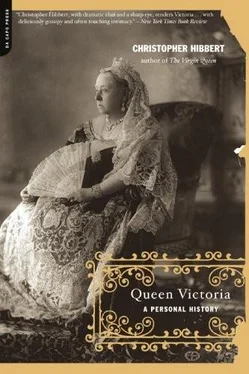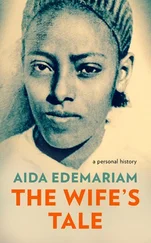Christopher Hibbert - QUEEN VICTORIA A Personal History
Здесь есть возможность читать онлайн «Christopher Hibbert - QUEEN VICTORIA A Personal History» — ознакомительный отрывок электронной книги совершенно бесплатно, а после прочтения отрывка купить полную версию. В некоторых случаях можно слушать аудио, скачать через торрент в формате fb2 и присутствует краткое содержание. Жанр: Биографии и Мемуары, на английском языке. Описание произведения, (предисловие) а так же отзывы посетителей доступны на портале библиотеки ЛибКат.
- Название:QUEEN VICTORIA A Personal History
- Автор:
- Жанр:
- Год:неизвестен
- ISBN:нет данных
- Рейтинг книги:5 / 5. Голосов: 1
-
Избранное:Добавить в избранное
- Отзывы:
-
Ваша оценка:
- 100
- 1
- 2
- 3
- 4
- 5
QUEEN VICTORIA A Personal History: краткое содержание, описание и аннотация
Предлагаем к чтению аннотацию, описание, краткое содержание или предисловие (зависит от того, что написал сам автор книги «QUEEN VICTORIA A Personal History»). Если вы не нашли необходимую информацию о книге — напишите в комментариях, мы постараемся отыскать её.
QUEEN VICTORIA A Personal History — читать онлайн ознакомительный отрывок
Ниже представлен текст книги, разбитый по страницам. Система сохранения места последней прочитанной страницы, позволяет с удобством читать онлайн бесплатно книгу «QUEEN VICTORIA A Personal History», без необходимости каждый раз заново искать на чём Вы остановились. Поставьте закладку, и сможете в любой момент перейти на страницу, на которой закончили чтение.
Интервал:
Закладка:
She was now almost destitute and it was left to her brother, Prince Leopold, to come to her aid. Without his help, he later assured her daughter, Victoria, the Duchess could not possibly have remained in the country. The Regent's 'great wish was to get you and your mama out of the country,' he told her emphatically. 'And I must say without my assistance you could not have remained ... I know not what would have come of you and your mama, if I had not then existed.' 15
But Prince Leopold not only existed but still had so large an income that he could well afford to take his sister and his little niece into his care. He asked the Regent's sister, Princess Mary, Duchess of Gloucester, to seek permission from her brother - who was as fond of her as she was of him - to allow the stricken widow and her daughter to return to her late husband's apartments at Kensington Palace. 'Her situation is most melancholy,' Princess Mary wrote, 'for Edward had nothing in the world but debts & now there are all his old servants without a penny piece to provide for them. She knows what your goodness of heart is & she is sure you will do what you can for them. ' 16The Regent immediately gave his consent; and so the Duchess of Kent, assured of an annual allowance from Prince Leopold of £2,000, later increased to £3,000 a year, returned to Kensington Palace where they learned that the poor, blind, demented King had died at last on 29 January 1820 and the Prince Regent was now King George IV.
Chapter 3
THE CHILD
'I never had a room to myself. I never had a sofa, nor an easy chair, and there was not a single carpet that was not threadbare.'
The King's little niece, Victoria, was now eight months old. She had not been well at Sidmouth, suffering from a heavy cold for most of the time; and she had been Very upset by the frightful jolting' of the carriage that brought her back to Kensington. But she was a strong child, as her father had been pleased to note of his 'little joy'; and at six months she had, in his opinion, been 'as advanced as children generally are at eight'. She had been vaccinated without ill effects and having been weaned - her mother having caused some disapproval by indelicately insisting on giving what her husband described as 'maternal nutriment' - 'she did not appear to thrive the less for the change'. The Duchess was delighted with her little 'Vickelchen', as she called her, although she had to admit that she was already showing 'symptoms of wanting to get her own little way'.
This stubbornness and independence of spirit became more pronounced as she grew older. So did her impatience, her wilfulness, outbursts of temper and defiant truthfulness. Frustrated, she would stamp her feet and would burst into tears when told to sit still or to pay closer attention during her reading lessons; and once, in a tantrum, she hurled a pair of scissors at her governess. Before her lessons began one day, her mother was asked if she had been a good girl that morning. 'Yes,' the Duchess replied, 'she has been good this morning but yesterday there was a little storm.' 'Two storms,' corrected the little girl, pertly interrupting her mother's account, intent as always on speaking and hearing the truth, 'one at dressing and one at washing.' She was similarly pert when her mother said to her, after one of her outbursts of temper, that she made them both very unhappy by such behaviour. 'No, Mama, not me, not myself, but you.' 1
The Duchess's nervous temperament was not well adapted to dealing with such a child. 'To my shame,' she admitted, 'I must confess that I am over anxious in a childish way with the little one, as if she were my first child ... She drives me at times into real desperation ... Today the little mouse ... was so unmanageable that I nearly cried.'
Wilful as she was, however, the little girl, intelligent and lively and with an astonishingly retentive memory, progressed satisfactorily with her lessons when these began to a regular timetable supervised by her Principal Master, the Revd George Davys, a Fellow of Christ's College, Cambridge, later Bishop of Peterborough. Davys came to live in Kensington Palace before the Princess was four years old. He helped to teach her to read by writing short words on cards and, as he put it, 'making her bring them to me from a distant part of the room as I named them'. 2Admittedly, she was not very good at Latin, and piano lessons were often a trial: once, when told that there was 'no royal road to success in music' and that she must practise like everyone else, she banged shut the lid of the instrument with the defiant words, 'There! You see there is no must about it.' But she was patient and attentive in her history and geography lessons; she learned to speak French and German - the latter in particular with a 'correct pronunciation' - and a little Italian. [i] Her first Prime Minister, Lord Melbourne, was later to comment, 'She is far too open and candid in her nature to pretend to one atom more knowledge than she really possesses ... and yet, as the world goes, she would, as any girl, have been considered accomplished, for she speaks German well and writes it; understands Italian, speaks French fluently, and writes it with great elegance' (Benson and Esher, The Letters of Queen Victoria, ist Series, i, 256: memorandum of George Anson, 15 January 1841).
She soon became adept at arithmetic; her written English was exemplary and her soprano singing voice, trained by John Sale, the organist at St Margaret's Westminster, was delightful. She danced with easy grace, she listened dutifully to Mr Davys's religious instruction, she read poetry 'extremely well', he said, and understood what she read 'as well, as at her age, could reasonably be expected'. She displayed a precocious skill in drawing at which she was given lessons by Richard Westall, the prolific historical painter and book illustrator, and later, by Edwin Landseer, Edward Lear and William Leighton Leitch, the distinguished watercolourist. 3
In March 1830, when the Princess was ten years old, the Duchess decided that her daughter should be examined to ensure that her education was proceeding along the correct lines. The two invigilators chosen were Charles Blomfield, Bishop of London, described by Richard Porson, Regius Professor of Greek at Cambridge, as a 'very pretty scholar', and John Kaye, Bishop of Lincoln, who had been elected Master of Christ's College, Cambridge at the age of thirty and Regius Professor of Divinity two years later.
Having examined the Princess, these two eminent scholars expressed themselves as being 'completely satisfied' with her answers.
In answering a great variety of questions [they reported] the Princess displayed an accurate knowledge of the most important features of Scripture, History and of the leading truths and precepts of the Christian Religion as taught by the Church of England; as well as an acquaintance with the Chronology and principal facts of English History, remarkable in so young a person. To questions of Geography, the use of Globes, Arithmetic and Latin Grammar, the answers which the Princess returned were equally satisfactory, and Her pronunciation both of English and Latin is singularly correct and pleasing. Due attention appears to have been paid to the acquisition of modern languages; and although it was less within the scope of our enquiry, we cannot help observing that the pencil drawings of the Princess are executed with the freedom and correctness of an older child. 4
In later years she spoke of her childhood as being lonely and 'rather melancholy' and Kensington Palace as being bleak in the extreme. 'I never had a room to myself,' she complained. 'I never had a sofa, nor an easy chair, and there was not a single carpet that was not threadbare.' The food was boring and unappetizing: she promised herself that when she was grown up and could eat as she liked, she would never have mutton for dinner again. Yet the events of her early life as she recorded them were far from being all unhappy ones. Certainly there were recollections of bogeymen: she had 'a great horror of Bishops' with their strange wigs and incongruous aprons and of the Duke of Sussex, 'Uncle Sussex', who, she was told, would appear from his nearby rooms in the Palace and punish her when she cried and was naughty. She remembered screaming when she saw him. 5But she was fond of her father's old preceptor, the kindly John Fisher, Bishop of Salisbury, who used to kneel down beside her and let her play with the badge he wore as Chancellor of the Order of the Garter; and she was fond, too, of her uncle, the childless Duke of York, who was very fat and very bald and held himself in such a way that it always seemed as though he would tumble over backwards. He was 'very kind' to her and gave her 'beautiful presents' including a donkey, and once he presided over a memorable party for her at the house of a friend where there was a Punch and Judy show. 6As for her uncle, King George IV, he paid little attention to her when she was taken by her mother to see him at Carlton House; but one day while she was staying near Windsor with her aunt, the Duchess of Gloucester, at Cumberland Lodge, she was driven over to see the King at the Royal Lodge and found him in one of his happier moods. 'Give me your little paw,' he said, affectionately taking the hand of the seven-year-old child in his, and then pulled her on to his stout knee so that she could kiss him. It was 'too disgusting', she recalled more than half a century later, 'because his face was covered with grease-paint'. But at the time she had responded to his 'wonderful dignity and charm of manner': he never lost his way of pleasing young children. 'He wore the wig which was so much worn in those days,' she remembered clearly. 'Then he said he would give me something to wear, and that was his picture set in diamonds, which was worn by the Princesses as an order to a blue ribbon on the left shoulder. I was very proud of this - and Lady Conyngham [the King's plump and stately intimate friend, supposedly his mistress] pinned it on my shoulder.' 7
Читать дальшеИнтервал:
Закладка:
Похожие книги на «QUEEN VICTORIA A Personal History»
Представляем Вашему вниманию похожие книги на «QUEEN VICTORIA A Personal History» списком для выбора. Мы отобрали схожую по названию и смыслу литературу в надежде предоставить читателям больше вариантов отыскать новые, интересные, ещё непрочитанные произведения.
Обсуждение, отзывы о книге «QUEEN VICTORIA A Personal History» и просто собственные мнения читателей. Оставьте ваши комментарии, напишите, что Вы думаете о произведении, его смысле или главных героях. Укажите что конкретно понравилось, а что нет, и почему Вы так считаете.











